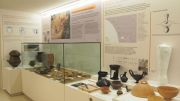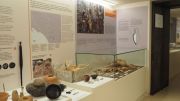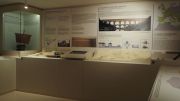In addition to the technological revolution linked to the use of the iron, a new metal used for the realization of weapons and very durable tools, this room offers an overview on the development of the big colonizer civilizations as Phoenicia and Greeks, that promoted the cultural evolution of numerous Italic populations.
Italic populations base their economy on breeding, agriculture and exploiting of mineral resources.
Their cultures was very different but always influenced by Greece and the East.
So noble groups started to adopt rituals such as banquets, symposium and exchange of gifts between leaders.
In this showcase there is the reconstruction of an Etruscan sailing ship used for the trade;
behind it there are the reconstructions of two hulls cutaways, one built with the technique with “mortise and tenons”, the other on with the “sewn” technique.
The Etruscan presence in Versilia is very strong: from San Rocchino (Massarosa) come objects imported from Southern Etruria and from Greece, confirming the function of this area both as an emporium and as arriving point.
Here are displayed the most significant potteries (for example, bucchero, black ceramic, and dolium), together with the finds coming from small Etruscan living centers in Camaiore's territory (Marignana, Acquarella). There are numerous reproductions of buccheros and potteries from living centers and burials in Versilia.
In Hellenistic Age, the Apuan territory is populated from Apuan-Ligurians, but that were in a constant interchange with Etruscan and Roman populations, as proven by the burials in cases made of stone from Vado (Camaiore), and numerous metal materials and amphoras coming from occasional recoveries in mountainous areas.
There are also many others objects from the Etruscan civilization such as metal fibulas, hut-made cinerary urns and bucchero ceramic. Furthermore you can experience the writing on the wax tablet.









